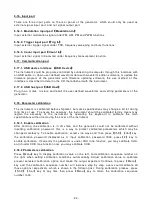
5.9.2. Sweeping time
Press
【
Menu
】
key and select “Time” option and then set sweep time value. Sweep time means
the time of sweeping from the start frequency point to the end frequency point. The sweep time of
every frequency point is the same, so the longer the sweep time is, the more frequency points are
swept, the less the step of the frequency point is, and the finer the sweep is. The shorter of the
sweep time is, the less frequency points are swept, the more the step of the frequency point is,
and the rougher the sweep is.
5.9.3. Sweeping mode
Press
【
Menu
】
key and select “Mode” option to set sweeping mode. There are only two value of
sweeping mode: 0 and 1, Set the value as 0 to select “linear” option, and the sweeping mode now
is linearity. Set the value as 1 to select “log” option, to select logarithm mode.
Under linearity sweeping mode, the frequency step is fixed, but a fixed frequency step always
does a bad effect when sweeping comparatively wide-range frequency. In that case, the
resolution is high when sweeping high end of frequency, the frequency changes slowly, and the
sweeping is fine. But the resolution is low when sweeping the low end of frequency, the frequency
changes very quickly, the sweeping is rough. So linearity sweeping is applicable only for
sweeping with narrow frequency range.
Under logarithm sweeping mode, the frequency step value is not fixed but changes according to
logarithm relation. When sweeping the high end of frequency, the frequency step value is
comparatively large; when sweeping the low end of frequency, the frequency step value is
comparatively small. The frequency change is comparatively average for sweeping with wide
frequency range. So logarithm sweeping is applicable for sweeping with wide frequency range.
5.9.4. Trigger source
Press
【
Menu
】
key, select “Source” option and then set trigger source, there are only two values
to choose: 0 and 1. Set the value as 0 to choose internal trigger source, and set it as 1 to choose
external trigger source. If external trigger source is chosen, the sweeping will stop when reaching
to the end point, then each time you press
【
Shift
】【
trig
】
keys, the sweeping will run once, then
stop on the start frequency and wait for next trigger. External trigger signal could also be chosen,
connect a TTL trigger signal to the
《
Trig In
》
port on the rear panel of the generator. The
sweeping will run once at the rising edge of each trigger signal. Of course, the period of trigger
signal should be longer than sweeping time.
5.9.5. Sync output
During frequency sweeping, the
《
Sync
》
port on the front panel output a sync signal. A sync
signal is a pulse wave signal with TTL level, of which the rising edge of the pulse is match along
with the start point of the sweeping, and the falling edge is match along with the middle point of
the sweeping area, the period of the pulse wave is the same with sweeping time.
Under sweeping function, press
【
Sweep
】
key(the “Sweep” key-light will be off) to exit frequency
sweeping function and return back to continuous function.
5.10. Burst
It is explained that in burst mode, the word “burst” means the cycle of any waveform, not only the
pulse. In burst output, instrument outputs continuously a series of burst or trigger and output a
single burst according to repeated period, pulse count and start phase set. All the 16 waveforms
listed in the waveforms table could be used as burst waveform. Before entering into burst function,
users should firstly set the waveform, frequency and amplitude value of the burst under CHA
continuous function.
Press
【
Burst
】
key to light “Burst” keyboard indicator, the CHA will output burst signal.
-18-


























